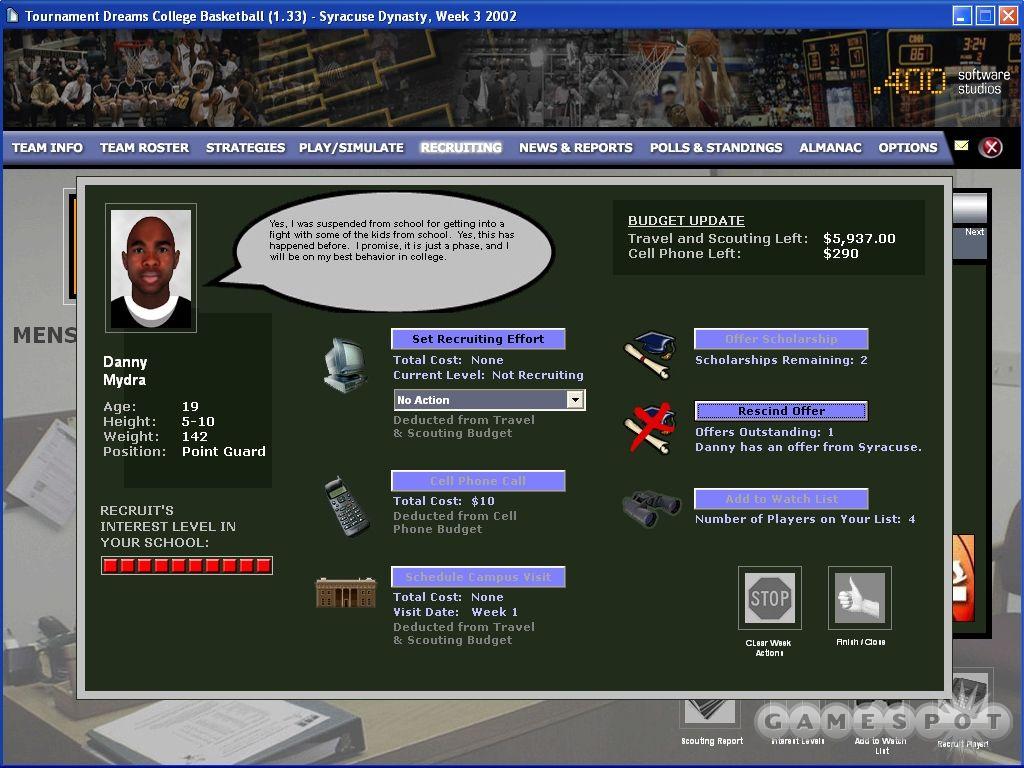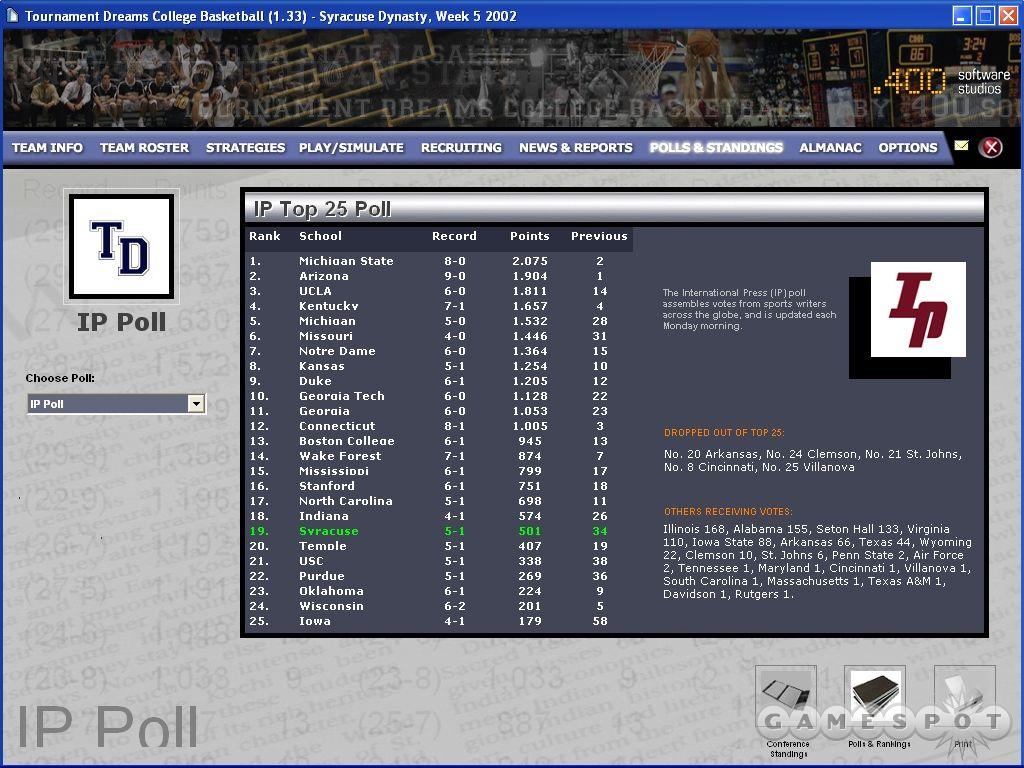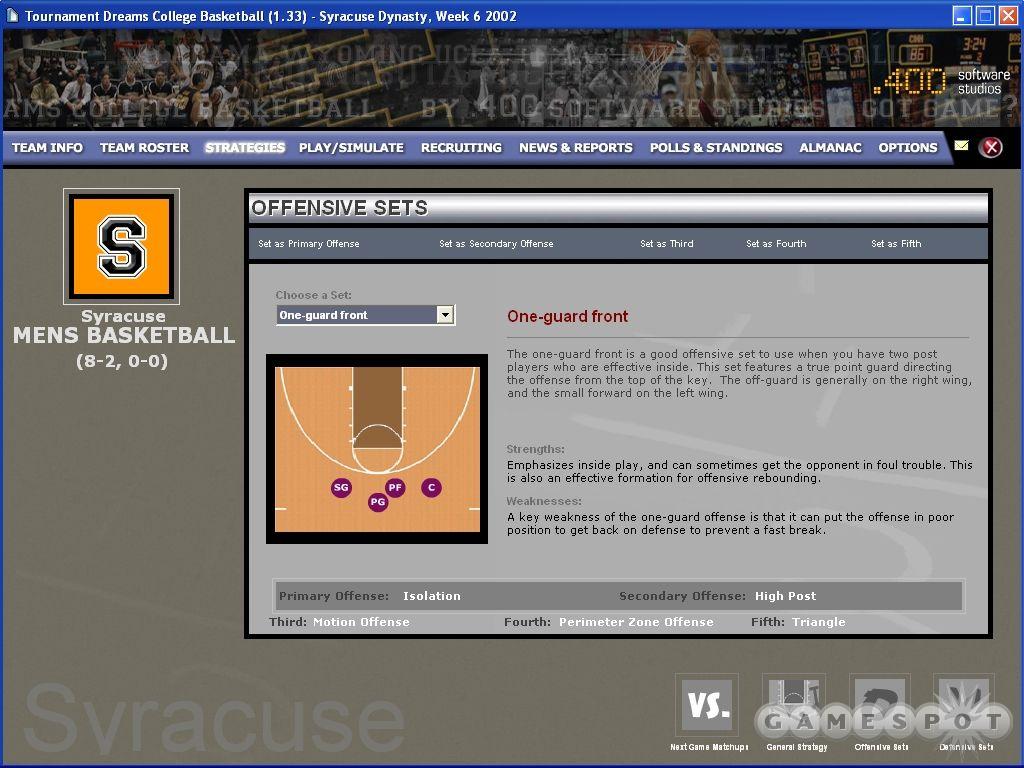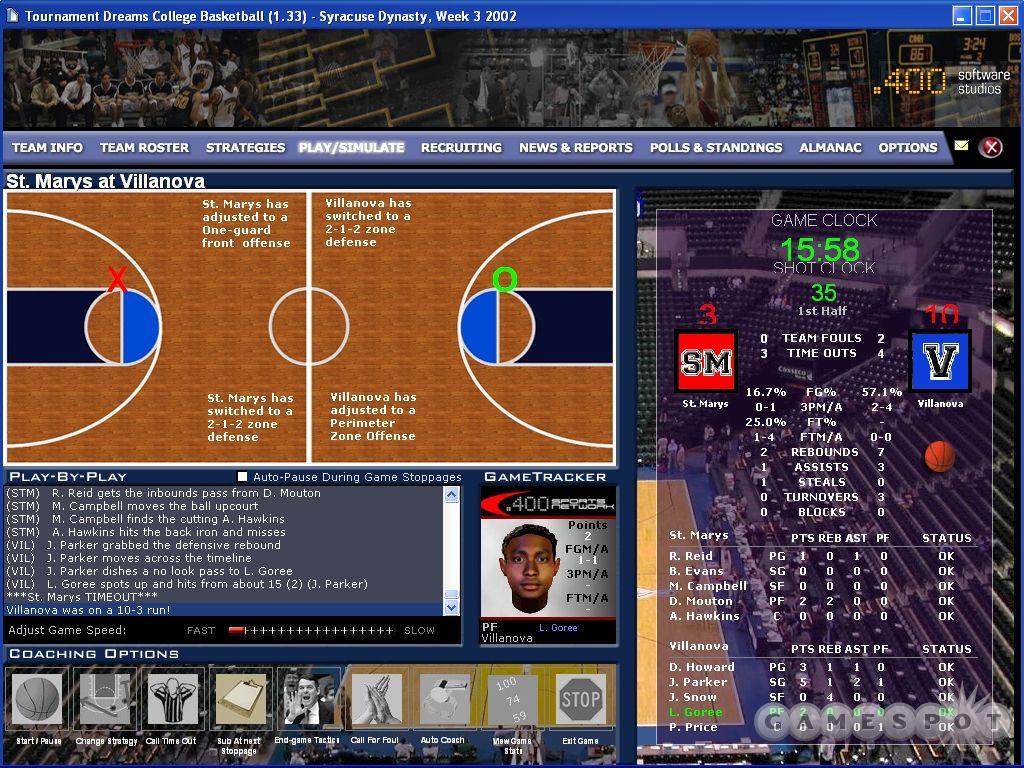Sports management simulations have become so prolific of late that lines are beginning to blur. Since everybody is working off the same stellar Championship Manager template, all sports are beginning to feel the same. If not for a few graphics and different stat categories, it would be hard to tell the difference between a football game and a hockey game, since you're fulfilling the same management tasks no matter if you're dealing with pigskin or pucks.

So Tournament Dreams College Basketball comes as a blast of much-needed fresh air to the somewhat predictable pro-sim scene. The .400 Software Studios title stands apart from most of its rivals by focusing on the college game. Instead of simply adding some routine recruiting and program-building options to an NBA sim, the developers have turned the design philosophy on its ear by building around the unique nature of college basketball. Basketball almost takes second chair to the yearly recruitment drives that are vital to developing a Division I powerhouse. This gives the game both an impressive (almost unparalleled) authenticity and a very different (somehow friendlier) atmosphere from the usual text-based sim dealing with professional leagues.
The basics of the game are about what you would expect. You take over the basketball program at one of 320 Division I colleges spread across the country and gain complete control over everything from calling up potential recruits to scheduling games to setting a starting five. You can play solo or go online to take on friends in multiplayer leagues. Game difficulty is dependent on the school you choose, since each program has different strengths and goals. So, for instance, running Syracuse--with its powerhouse freshman class, solid reputation, and big bucks--is a lot easier than running a traditionally weak sister school, like Maine. Of course, with bigger schools come bigger expectations. Where the powers-that-be at Stanford aren't happy with anything less than a conference championship and a subsequent strong showing in the national tournament, the folks running things at Baylor are a lot more tolerant of a losing season.

The best way to avoid offending your boss is, of course, to win a lot of games. And the best way to do that is to recruit top talent each year to make sure you're always able to send a contending club onto the hardwood. To reflect the importance of recruiting, .400 Software Studios has made it the heart of Tournament Dreams. For starters, it runs concurrently with the season, which means that you have to simultaneously keep an eye on playing games with the current squad while also recruiting players for next year's squad. This gives play an organic feel. You can go from offering a scholarship to a budding superstar in a local high school one moment to that big showdown with a divisional rival the next. Everything dovetails together in a way that you don't see in pro-sports sims, largely because you can make up for poor drafts in those games by signing free agents. Here, the draft and free agent markets are one and the same, so mistakes can cripple your program.
Another plus with the game's recruiting is its realism. While you do hire a scouting service to provide player ratings and numbers in a long list of categories, like offensive awareness and inside scoring, convincing a player to commit to your school involves hard selling. You typically start off with a phone call to gauge the interests of the players that your scouting service has identified as possibilities. Then you proceed to mount an aggressive, moderate, or light recruiting campaign. Finally, you offer campus visits and scholarships. Everything you do takes a chunk out of your weekly recruiting budget. In fact, even your phone calls are restricted to $300 a week--and remember that it costs more to call cross-country than it does to call within your home state--so economizing is a must.
Dedicating your efforts solely to those players you have a chance to sign is crucial. Incessant recruitment efforts stand the most chance of convincing a player to commit to your school. You need to go back to a few key targets week after week, and you mustn't spread your efforts around. Of course, this can be heartbreaking. Players take many weeks to commit, and in the meantime, they can run into trouble at school, be downgraded by scouts, declare their eligibility for the pro draft, or simply decide that another school is a better bet. Sometimes the sure things bail on you at the last minute. Sometimes an underdog has a change of heart and chooses you over rivals when you least expect it.

The whole process is remarkably true to life. A big reason for this is varied phone dialogue. There seem to be dozens, if not hundreds, of different player responses available. There are enough so that repetition is never an issue. It seems like you're talking to real people, too, since their conversations are so wide-ranging. Instead of canned "not interested" phrases, a player might blow you off with comments like "I feel Jar Jar Binks is misunderstood." or "You think I'm good? You should see my little brother." The same goes for positive responses, where players talk about their strengths on the court or how they've always dreamed of playing for your school. Late recruits even add a touch of desperation. One low-ranked potential we spoke to was only concerned about how many tickets to the Big East Tournament he could score and if it was OK to sell them. Others talk about getting kicked out of school for fights. The developers obviously took a lot of time with this dialogue, and the result is the inclusion of players who act like real individuals with identifiable personalities.
.400 Software Studios also spent a lot of time on refining other aspects of the simulation. Team control is as fully featured as the recruiting engine. For simmed contests, you set up a depth chart, choose primary and supporting offensive and defensive strategies, and even establish substitution patterns and player roles. Games can also be manually played, thus giving you on-the-fly access to all of the strategic options, time-outs, and last-minute shot instructions. There is a lot of depth here, but you don't have to be a basketball expert to appreciate everything. The program walks you through every step of each season via an e-mail interface, and more-intricate features, like the offensive and defensive strategies, are described both with text and with moving diagrams. While Tournament Dreams might not make you a basketball coach, it will give you enough information to fake it.

Friendly and attractive graphics go along with the personable presentation. Every screen is colorful and easy to read, and many boast visuals that give the game a lot of life. Every player is represented by a picture; the recruitment screen features graphics of all the options; and even the player ratings are represented by big, red boxes. This is the most attractive sports sim we've ever seen. The emphasis on production values extends to sound as well. The background music consists of a varied original soundtrack that mixes hip-hop with school-marching-band tunes. It's very catchy. All menu functions come with unobtrusive sound effects. Crowd noises and auditorium sounds accompany the manual simming of games, and these aren't just generic noises. The crowd actually reacts to events on the court with boos and cheers, and the stadium announcer calls out "Going to the line. Shooting two." every time a player goes to the charity stripe. Frills like these are almost unheard of in the bargain-basement world of the typical text-based sports management simulation.
Any way you look at it, Tournament Dreams is an outstanding achievement. College basketball has never been so thoroughly, enjoyably re-created. Sports management sims are rarely so captivating, no matter what real-life pastime they represent. Add to this solid developer support and regular updates that are still being released, and you have an absolute must for college basketball fans who need a fix now that March Madness 2004 has come to a close.